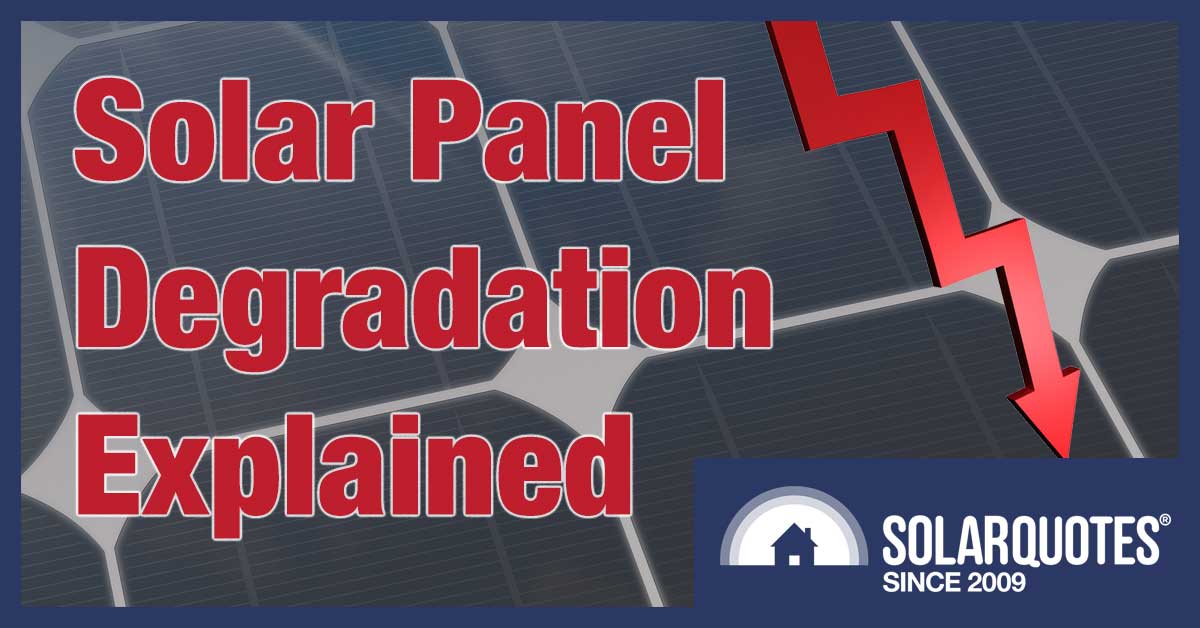
Solar panels are amazing things. They cut pollution, save planets, and — by draining its power — move us closer to humanity’s ancient dream of destroying the sun. But they’re not quite perfect. If you happen to buy the cheapest panels you can get your hands on I’m sure you’ll soon find they can be very far from perfect. So bloody far you’ll need a goddamn spaceship to get there.
But if you limit yourself to buying panels we have reason to believe are good quality, such as those on our solar panel comparison table or the graphic below from our Solar 101 Guide, then the odds are you’ll get something decent:
All these panels will slowly degrade in output as they age. But, unlike some, I’m certain the performance warranties1 from the brands above actually mean something. At minimum these warranties promise the panels will still have at least 80% of their nominal capacity2 after 25 years. But if you pay extra for the very best performance warranty, which comes with Sunpower’s X and E series panels, it states they will have 92% or more of their nominal capacity after 25 years.
Fortunately, just because performance warranties set minimum outputs that doesn’t mean the actual outputs will hug close to them. Predicting just how much solar panels will degrade over a quarter of a century is tricky, so performance warranties include a margin of error. As time goes by evidence is mounting that, on average, panels can be expected to exceed their performance minimums with a reasonable margin of safety.
This is for panels of decent quality. Crap panels can fall apart after a few years and you’ll have a hard time getting warranty support from a crap panel manufacturer. You can expect them to provide about as much support as a cardboard couch in the waiting room of a sumo wrestling ring.
In this article I’ll quickly cover the causes of panel degradation, explain how performance warranties work, and provide evidence solar panels can go the distance.
Causes Of Solar Panel Degradation
Panels slowly decline in output over the years as tiny cracks develop in the silicon solar cells — known as microcracks — and electrical connections deteriorate. If degradation becomes severe it can lead to a runaway effect where damage begets damage causing panel deterioration to accelerate; rapidly resulting in complete failure. Fingers crossed this won’t happen to any solar panel you purchase within its performance warranty period.
The main contributors to panel deterioration are:
- Thermal cycling: Materials expand and contract at different rates with temperature changes. This puts joins between different materials under strain and causes slow deterioration. The main temperature change — or thermal cycle — occurs between night and day, but there can be many thermal cycles during a day as the sun goes behind clouds or rain hits panels.
- Dynamic Mechanical Load: This is a fancy term for flexing caused by wind. While properly clamped panels won’t flex much, it’s still enough to cause damage over time.
- Humidity: The combination of high heat and humidity found in tropical Australia can be hard on solar panels. Crap ones can literally fall apart as the glue holding them together gives up the ghost. It can also contribute to a form of electrical deterioration known as PID. This is short for Potential Induced Degradation and is basically caused by naughty electrons going where they’re not supposed to or, more accurately, it’s caused by naughty panels that don’t keep electrons under control.
- UV damage: This isn’t a serious problem for decent solar panels that have quality UV blockers in the epoxy (glue) that holds them together. But if a crap manufacturer leaves it out to save a few dollars per unit they will start to turn yellow in the sun and in extreme cases the panel will come apart as its glue is destroyed.
- Freezing: If water can enter joints and seals and the temperature falls below freezing, ice expansion can contribute to deterioration. Fortunately, our climate makes this a minor problem. While there are places here with frosts, panels are generally designed for far frostier locations.
Degradation Is Measured In Percent — Not Percentage Points
When it comes to solar panels there are two percentage figures people are reasonably familiar with. These are:
- Solar Panel Efficiency: This is how much of the light energy falling on the panel gets converted into electrical energy. These days panels are typically around 17% efficient.
- Solar Panel Degradation: For many panels this is given as 2% to 3% in the first year and then 0.7% a year after that, but it can be as low as 0.25% a year for some SunPower panels. Note these figures may have a minus sign in front of them as in -0.7% or -0.25%.
It’s a good idea not to get these percentages confused. If a panel that’s 17.1% efficient degrades by 3%, it doesn’t lose 3 percentage points to become a 14.1% efficient module. It only falls by 3% down to 16.59%.
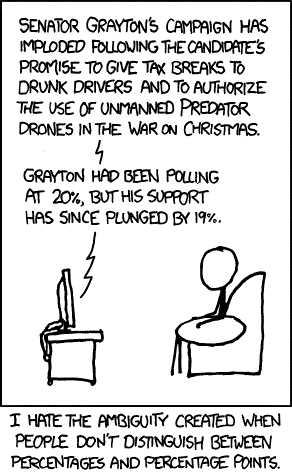
Image: XKCD
To further bludgeon my point home, if after 25 years a 17.1% panel degraded by 20% it wouldn’t become a vampire panel with negative 2.9% efficiency that sucks power out of nearby electrical cables when exposed to sunlight. Instead its efficiency would merely drop to 13.68%.
The Greatest Degradation Is On Day 1
Solar panel performance warranties generally allow for 2-3% degradation in their first year and 0.7% or less each year after. The reason why they allow for extra degradation early on is not because panels degrade rapidly in their first year. It’s because they degrade rapidly in their first few hours.
Light Induced Degradation, or LID, affects most solar panels and reduces their efficiency by 1-3% during the first few hours they are exposed to sunlight. Science says:
“This is caused by oxygen impurities in crystalline silicon bonding with boron dopant to produce a boron oxygen complex that reduces the minority carrier diffusion length.”
Exactly why boring dopes are forming relationships with oxygen that are “complex” and then mucking about with minorities is beyond me. All I know is this is impossible to avoid with the most common solar cells that are P-type while the more expensive and exclusive N-type cells don’t have this problem. However, their performance warranties still seem to allow for a similar performance drop early in their lives. I presume this is to make their performance warranties look better as it helps keep the yearly degradation figure low and that is what people are likely to use to compare performance warranties.
Performance Warranty Examples
I’ve put graphs showing the performance warranties for a variety of panels below and I’m starting with Jinko — the world’s largest manufacturer. This graph shows the performance warranty of one of their monosilicon3 solar panels:
For this particular panel Jinko allows for a 3% decline in performance in the first year followed by 0.7% a year after that with a minimum output of 80.2% after 25 years.
The grey area on the chart labeled “Standard performance warranty” represents a very simple two step warranty that went out of style a long time ago. No panel I’d recommend would have this today. Despite its age and rarity manufacturers like to include it in performance warranty graphs to make their warranties look better.
Next is a Q CELLS polycrystalline4 panel. It does better than the lower cost Jinko panel with a minimum of 83% of nominal output after 25 years.
This is for a Longi monocrystalline PERC panel which promises at least 84.8% after 25 years:
As you’ve probably noticed, the examples keep getting better. And here’s the cream of the crop5 — the Sunpower X and E series performance warranty:6
This promises no more than a 2% decline in year one followed by no more then 0.25% degradation per year. This means it should have at least 92% of its nominal capacity after 25 years. I wouldn’t be surprised if it was still operating at over 86% after 40 years.
Positive Tolerance Means Degradation Is Just A Little Worse Than It Seems
Solar panel production lines don’t produce perfectly identical products. Even with modern, highly controlled manufacturing processes there are slight variations in capacity between panels. How much a panel may differ from its nominal rating is given by its tolerance figure. These days most worth getting have positive tolerance. This means its capacity in watts when new will be the same or higher than its nominal rating. In the past panel tolerance was usually plus or minus, which meant its actual capacity could be a little over or a little under its nominal capacity. Because the wattage of solar panels with positive tolerance averages a little above their nominal amount they tend to have a little more room to degrade before they hit their performance warranty limits. The effect is not large but it does help.
Most Solar Panels Should Exceed Their Performance Warranties
Solar panel manufacturers really don’t like spending money to replace panels that fail to meet their performance warranties. There are many dodgy manufacturers who hate it so much they simply don’t. A representative of one lower cost panel producer cheerfully told me their performance warranty was “just a piece of paper.” I admired his honesty but there might be quite a few people who end up not admiring his company’s lack of honesty.
More trustworthy manufacturers who have warranties that actually mean something will still want to pay out as little as possible. Because of this the minimum performance they warrant is below where they expect the large majority of their panels to be at any point during the warranty period. For this reason we can expect most decent solar panels to, on average, exceed their performance warranties by a reasonable amount.
Solar Farms Harsher Than Rooftops?
Most solar panels are designed for use in large overseas solar farms. If average conditions there are worse than on Australian roofs then — all else equal — residential panels should be even less likely not to live up to their performance warranties. Solar farm panels can expect to suffer from:
- More dynamic mechanical loading from wind thanks to being in ground mounts that leave them more exposed and also generally windier locations.
- Higher UV levels due to sunnier locations and better panel orientation, including the frequent use of trackers that allow panels to follow the sun through the day.
- Much more frost on average.
On the other hand, rooftop solar can suffer from:
- Higher temperatures due to poor air circulation at the rear of the panel. This can exacerbate thermal cycling.
- Greater cloud cover resulting in more small thermal cycles during the day from intermittent cloud shading.
- Humidity plus heat is a problem in tropical Australia.
My guess is, overall, Australian roofs are on average a better environment than the average solar farm and so we can expect identical panels to degrade a little less on our rooftops. Unfortunately, it’s not uncommon for manufacturers to substitute cheaper and inferior materials if they know the panels will be used on residential roofs rather than in large solar farms where their performance will be carefully monitored to ensure they’re up to scratch. I sincerely hope major manufacturers selling in Australia value their reputations and don’t do this, but it can be difficult to detect until problems start to occur.
Evidence That Solar Panels Can Go The Distance
In 1984 the Japanese solar company, Kyocera, installed 43 kilowatts on the roof of the Sakura Solar Centre.
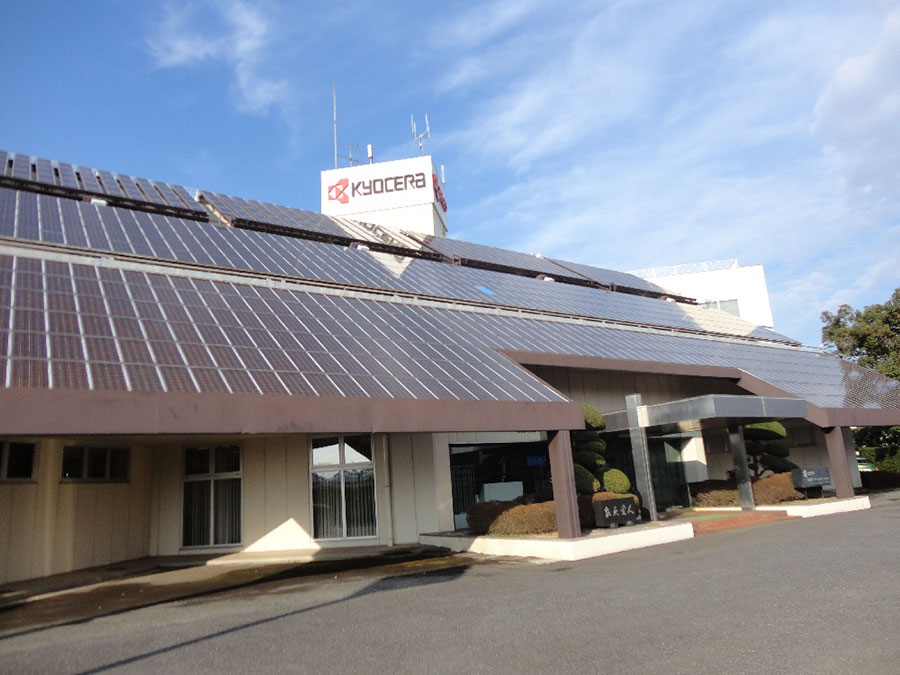
The Sakura Solar Centre in Chiba Prefecture, Japan.
Here is a very small graphic I found on a webpage about the Sakura Centre:
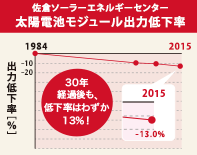
Image: Kyocera
As you can see, the graph clearly states:
“Squiggle squiggly squiggle squiggle squiggle 1984 — 2015. Big red dot squiggles -13.0%.”
I assume this means in the 31 years from 1984 to 2015 the solar panels only lost 13% of their original capacity. This is an average annual deterioration of only 0.4% and well below the 0.7% many warranties currently allow. After 25 years in operation — the length of a normal performance warranty — they were at around 90.5% of their nominal capacity.
But this result may only show that high solar quality panels can go the distance. It doesn’t really say anything about those that aren’t made by Kyocera. But the good news is I’ve concluded from reading the research article “Compendium of photovoltaic degradation rates” that if you didn’t cheap out and buy crap panels they are likely to safely remain within the limits of their performance warranty for a full 25 years. I will give you a sentence from their abstract, but in GIF form so it will stand out and because I enjoy getting giffy with it:
They found the average silicon solar panel in their study — and silicon is almost the only kind that gets installed on Australian roofs — degraded by 0.8-0.9% per year. This is worse than what any performance warranties offer, but the result was dragged down by crap panels. The median — or most common result — was 0.5-0.6% per year. This is safely within what most performance warranties allow and if you pay extra for a premium solar panel that promises an even lower rate of degradation I’m confident that’s what you’re likely to get.
Some Bad News
The bad news is, with most solar power systems, even if all but one of your solar panels are well within the limits of their performance warranty just one that isn’t can drag down the performance of others it’s connected to.
Another unfortunate fact is it can be very difficult to have the output of your panels accurately measured. To avoid the expense of a fruitless inspection7 you may need to wait until you are confident you have a problem rather than just suspicious.
But I will leave you with some good news and that is solar panel warranties are improving at an impressive rate as processes and materials improve. It may only be a year or two before I start considering any panel that only warrants 80% of nominal output after 25 years as being too low quality to recommend.
Footnotes
- Solar panels come with product warranties and performance warranties. Unfortunately, basically every performance warranty I’ve looked at is lousy. Fortunately, you are protected by Australian consumer law which, in my opinion, will require solar panel manufacturers to replace defective panels regardless of what the terms in their warranties may say. ↩
- A solar panel’s nominal capacity is its officially rated capacity when new. Its actual capacity will vary depending on its tolerances and how much it has degraded over time. ↩
- Monosilicon solar cells are made from one large silicon crystal and suffer from more LID than polysilicon panels. ↩
- Polycrystalline silicon is cheaper to make but less efficient than monosilicon. It also suffers from less LID. ↩
- Although when you think about it, if your crops are producing cream you have a very disturbing farm indeed. ↩
- Update 7th May 2020: As Randy Rolph has pointed out in the comments, the SunPower warranty promises 15% more power after 25 years and not 12% more as the graph below says. As this image is from SunPower it looks like their marketing department didn’t math good there. ↩
- Note that under Australian consumer law you can claim for damages and losses resulting from a defective product. This means, within reason, you don’t have to be out of pocket for an inspection if there is a problem with a panel. ↩

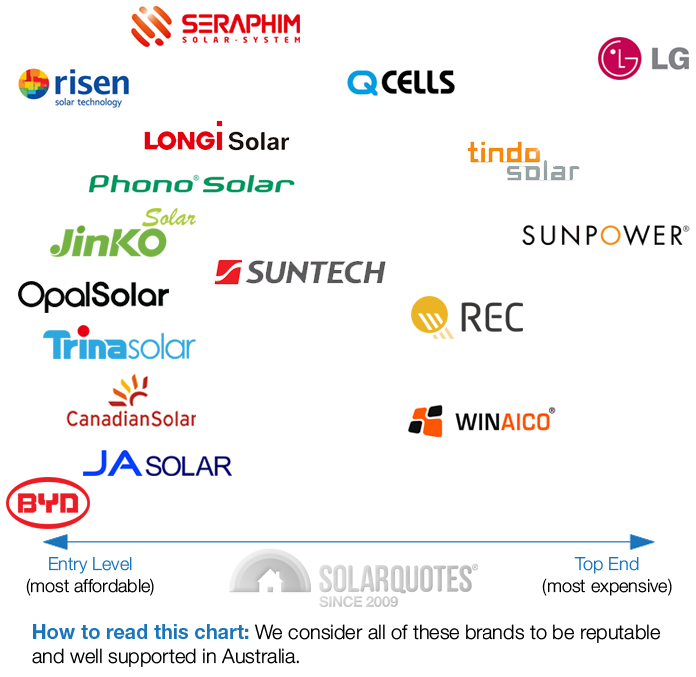
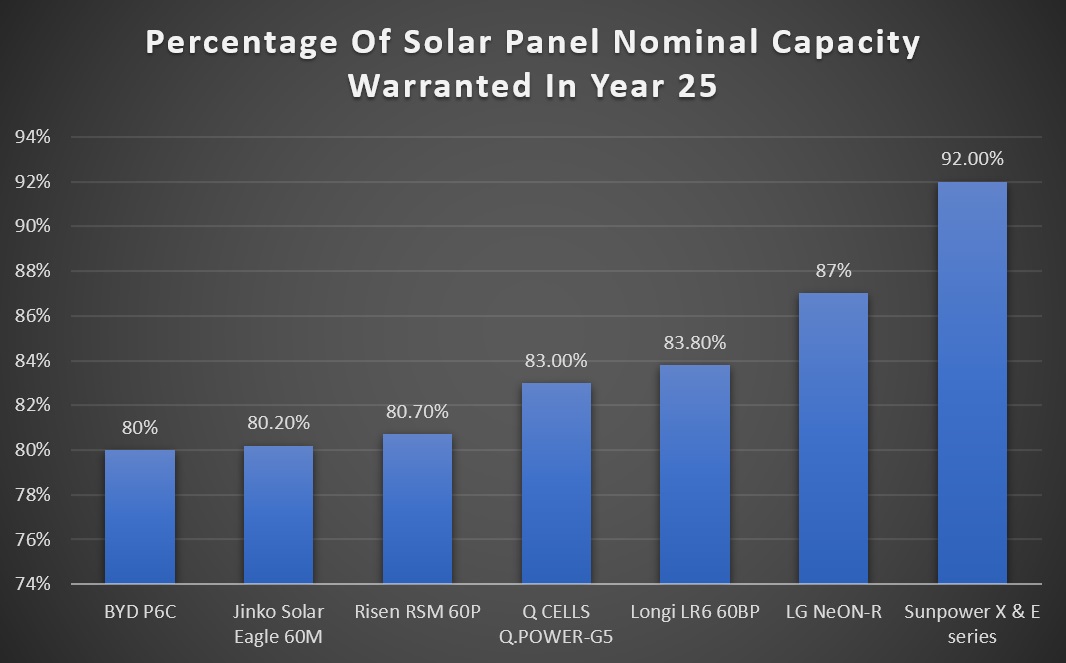
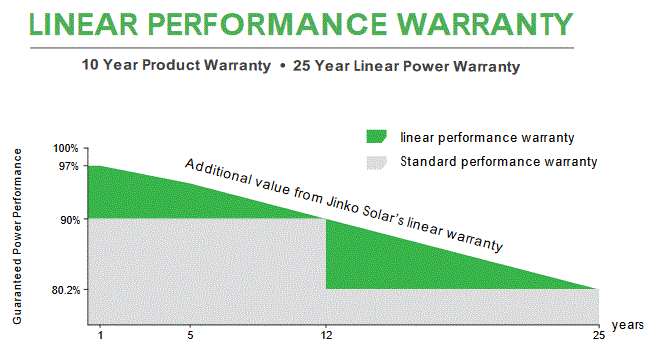
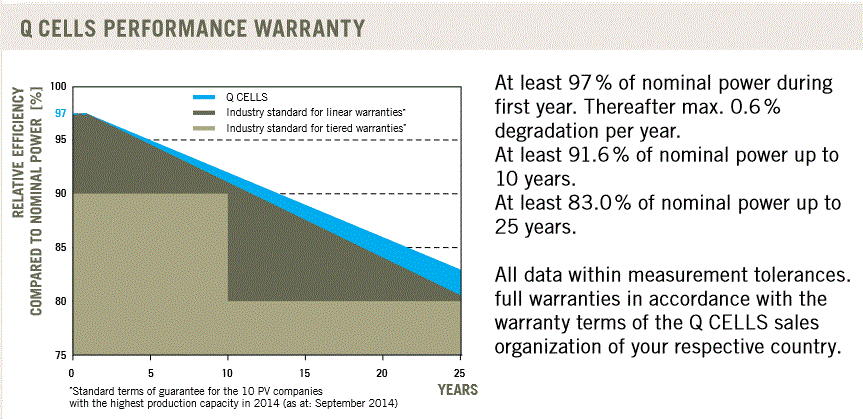
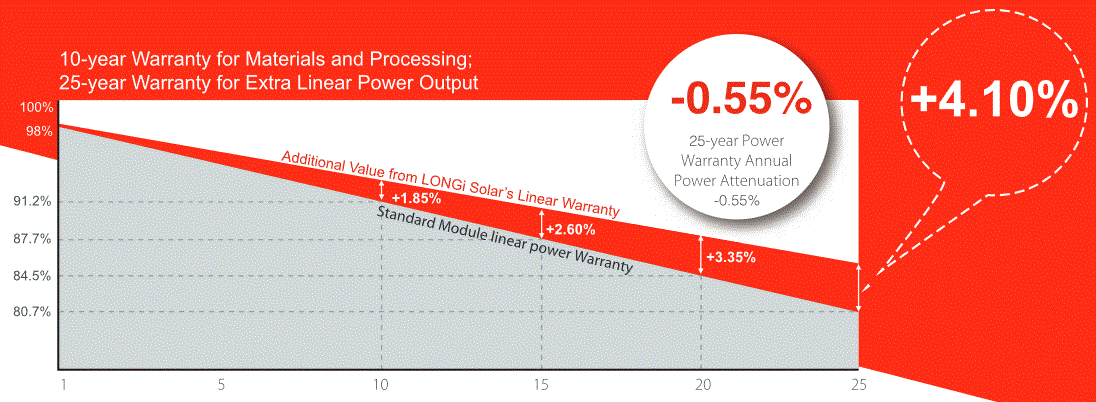
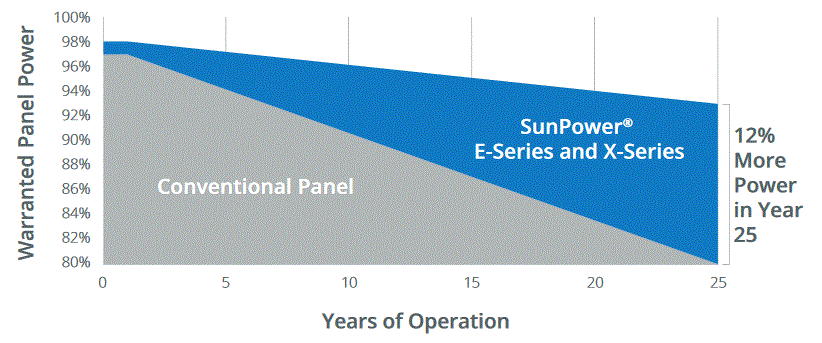

 RSS - Posts
RSS - Posts



Hi,
one elephant in the room that can affect cell performance is Hail storms. Not related to warranty, but can have an effect on performance.
In my case, we had huge hail (think cricket balls). The panels initially seemed OK. However after 6 months, you could see cell damage: there was a point impact on the cells that had cracks radiating out. The covering glass panel was not damaged, just the cells beneath. My home insurance replaced the system.
I upgraded the system to one with Optimisers (Solar edge). I actually recycled some of the damaged panels, & so far they are still working. (the system upgrade has the 30% extra panels, but I have an extra 2Kw (of recycled panels) on a 13Kw system, giving about 14,5Kw. I can monitor the panel performance to check failures, & even if a panel fails, the optimiser still lets the string work: a good compromise. My system also suffers from shading, hence the optimisers. Best daily o/p so far 85Kw.
Thanks for a nice review of panel degradation. How does one measure a panel’s degradation? I have 13 panels of one type (Silevo 305w) and 11 of another (Panasonic 325w) each with SE power optimizers. Their power output varies by multiple variables such as time of day, day of month, irradiance, temperature, etc. Is there a standard method that one can apply to measure output so that I can see how they are preforming? The average from my Silevo panels is less than 94% (305/325) of my average from the Panasonic panels and the Silevo panels have much wider individual variation between panels.
Thanks
Hi Thomas.
For most rooftop solar all that can really be done is to keep track of its output and see if it is declining. If you keep track of annual output it will vary year by year due to differences in cloud cover but if there is a general downward trend it’s good evidence you have a problem with your system and one or more panels could be deteriorating.
Comparing different panels is a little difficult as some simply perform a slightly better than others. So your Silevo panels may have degraded more than your Panasonic ones, but it could be their levels of deterioration are about the same but the Panasonic have always performed a little better.
Good topic, Young Fella, but you’re obviously not mindful of the wisdoms of Lazarus Long. (Google him up.) eg —->
” $100 placed at 7 percent interest compounded quarterly for
200 years will increase to more that $100,000,000 — by which
time it will be worth nothing.”
Are you seriously suggesting paying 20%/whatever more for an (alleged) increased lifespan of 7% ~ for panels you probably won’t own in 25 years anyway?
I’m saying that over time the performance warranties of all decent quality panels are likely to increase. For both lower end panels and for premium ones. So people on a budget buying lower cost panels will benefit along with those willing to spend extra for a higher quality product. One reason this will occur is because of constant tweaking to panel lines to improve the end product, and another reason is simply because time will have shown just how reliable their panels are in practice and those that have done well will have their warranties improved. I’m not saying it always makes sense to shell out more for a better performance warranty.
ps. LL…….”Everybody lies about sex.”
Solar panels, too.
Still thinking that a warranty for 25 years will be worth something in 10, 15 or 20 years from now. How many of the installers and suppliers will actually still be in business in 10, 15 or 20 years from now. About the only thing banks will lend on for a 10 25 or 20 year terms is an amortising home loan well secured by real estate. The warranties out more than a few years are a comfort, but your chances of picking which of these companies will still be around to honour them, and not fight every claim tooth and nail are almost nil. In the US PG&E is looking at seeking bankruptcy protection. In Australia an engineering firm with a 100 year history, RCR Tomlinson has recently got into financial trouble – what are their warranties and promises of payment worth?
Warranties are still a worthy thing and worht having, but don’t put too much faith or value in the idea of being able to claim under one in 10, 15 or 20 years time.
I go into this here:
https://www.solarquotes.com.au/blog/solar-panel-warranty-paradox/
The way I see it, a good warranty — from a company that is known to produce quality panels — is evidence that the panels will not require their warranty. If the very low panel failure rates some companies claim are correct then getting the right panel means — fingers crossed — you should never need to use the warranty.
Is there any way a hose holder can measure the ongoing performance/degradation of solar panels?
Also, what are the signs of degradation, or near-ultimate failure?
Thanks
For most solar systems it is simply a matter of keeping track of the output and, after it has been operating long enough, comparing the information year on year to see if there is a decline. Some years are sunnier than others but with enough time it’s possible to see if there is a downward trend. Normal degradation covered by warranties of 0.7% or less a year is a very slow decline and nothing to be concerned about. But if a panel has a serious problem you may see that your system’s output has dropped by a large amount and if a panel is on its way to soon failing completely there may be a clear decline month by month or even week by week.
My 19 year old Suntech mono panels are still pumping out at least 80%.
Not sure the exact degradation, but I am very happy about how well they have lasted.
Having no moving parts is the great advantage of Solar PV, I think.
I still have the original Sunnyboy inverter too.
Good to hear your panels are still doing well. I’m impressed by your Sunny Boy going the distance like that. Getting 19 years of use out of an inverter is damn good value.
I have Schott panels a little over 10 years old and I pull monthly stats and haven’t noticed any noticeable decline in performance.
They have a long record of quality solar PV and the long term test results below they are best in class or very close to the best available..
Schott 94.5 % stable performance over 25 years
External institutes in Europe and the U.S. accredit SCHOTT Solar modules above average lifetime of products and very little degradation in performance
Long-term performance tests run for 24 years by the ISE Fraunhofer-Institute
demonstrate that SCHOTT modules have extremely low degradation: an average of only 5.5 % since 1984
I think one needs many years of data before one can confidently identify the long term trend (if one lives where weather is variable). My system only has five years of data and so far the second year has been the highest output year. ( Note: The following figures are for a June 3 through June 2 installed date year, given in watt hours – so 12.3 to 12.7 megawatt hours per year.) System size is 7,650 Watts DC (6,750 Watts AC).
Year 1 12,354,113
Year 2 12,669,058
Year 3 12,392,419
Year 4 12,317,274
Year 5 12,512,204
Year 6 Estimated based on a little over a half year of production 12,852,341
Take away, I figure I’ll need at least ten years of observations before I can even determine if there has been any measurable degradation. So far weather in general seems to completely swamp the effect of degradation.
My system has mono crystal SolarWorld panels paired with Enphase M215 microinverters.
Your bar graph should start at zero on the Y axis if you want to illustrate your point better.
That’s a good point. I should have spent more time punching Excel until it gave me the graph I wanted.
The best way to describe one of our panels is “crazed”.
Can you tell me how this affects the single panel and the overall performance of the 8 panels we have please?
Hi Lawrie
There are a few things that could be:
If the glass sheet covering the solar panels is crazed then it is no longer doing it’s job of protecting the panel and it is likely it will rapidly deteriorate in performance and eventually fail altogether.
If the solar cells under the glass are crazed then they are full of tiny cracks. While the panel may have reasonable output at the moment its performance is likely to decline over time and again this can lead to eventual failure.
Another possibility is the there are no physical tracks but the cells have what look like snail trails on them under the glass. This is called PID (Potential Induced Deterioration). It may not have a large effect on the panel’s performance at the moment, but definitely could get worse.
Unless the panels have microinverters or optimizers — and the large majority don’t — then one poorly performing panel will drag down the performance of the others. With only 8 panels it is likely all of them will be dragged down to the level of the worst performer. I recommend checking the performance of the system and if it is clearly under performing you can make a warranty claim. Note you are protect by Consumer Guarantees and don’t have to be out of pocket to have a panel replaced:
https://www.accc.gov.au/consumers/consumer-rights-guarantees/consumer-guarantees
If your system isn’t clearly under performing then I suggest keeping an eye on it as it may start to rapidly deteriorate. Note, if you wish, you can make a claim based upon the panel’s appearance under your Consumer Guarantees regardless of what the written warranties say or the performance of the solar system.
Hi Ronald,
In regards to panel degradation I recently came across a topic (elsewhere) about Light and Elevated Temperature Induced Degradation and it being something that isn’t tested or understood very well by panel manufacturers. Have you heard about this before?
Hi
Light and Elevated Temperature Induced Degradation (LeTID) is a problem and it is worse in PERC cells. It is something that is accounted for in the allowed decline in performance in solar panels, although it is always possible it will turn out to be worse than expected in some panels. While undesirable, it does not have a large effect on solar panel efficiency. It isn’t well understood but its effects have been reduced simply by trying different things and seeing what works. Hopefully, they’ll work out how to prevent it, but if they can’t we’ll just have to lump it as we currently do.
hmmm all my 250watts barley do 100 Watts now ( 160w peak ) and that is across around 200 ground mounted panels and with at least 4 different brands and both Polly and mono types , on microinverters
5kw system on roof now averages 2.8kw and occasionally gets 3.5kw peak for a few minutes
cleaning did not seem to make much difference
What brands do you use?
I’m planning on a new installation in Cairns. Are there any particular brands/models of panels and inverters that are better suited to the wet tropics, what with high heat and humidity increasing degradation?
Hi Ronald,
You did a nice job explaining the proper way to calculate percent losses but then you flubbed that very concept yourself in your Warranty Panel Power chart comparing SunPower panels to conventional panels.
If SunPower panels degrade to 92% after 25 years, compared to 80% for a conventional panel, then that gives 92/80 = 15% more power after 25 years, not 12% more power.
My Sunpower panels have degraded less than 2% total after 7 years, which I find incredible, but it took giving them a much needed cleaning to realize they were still performing that well.
Oh yeah, I missed that. Good catch. That image is from SunPower, so it looks like their marketing team didn’t math well there. I’ll add a footnote pointing it out.
Thans for your useful information but the question is do you know how long to solar panels last?
If you buy tier one panels or ones from a manufacturer with a good reputation then you can expect them to last over 25 years. If you are willing to pay for high quality panels then I would expect most of them to still be working after 40 years (with some degradation). It’s important to be careful because poor quality panels can fail after just a few years.
Our solar 101 Guide has a graphic that shows all the panels we are confident are reliable and well supported in Australia:
https://www.solarquotes.com.au/solar101.html